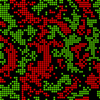Remote Ready Biology Learning Activities has 50 remote-ready activities, which work for either your classroom or remote teaching.
Serendip is an independent site partnering with faculty at multiple colleges and universities around the world. Happy exploring!

| Thinking About Segregation and Integration | 
|
Start by Observing the WorldLooking around, one finds humans more or less sorted into groups of similar people. Most readily noticed when the sorting occurs in terms of racial and ethnic features, there are all sorts of other ways that people also cluster in terms of similar characteristics. It is unlikely that there is a simple single cause for the sorting in any one case, much less that there is the same, single, simple cause for all of them. At the same time, it's curious that a similar phenomenon occurs in lots of different contexts, and one wonders whether there might be something similar that is contributing to all of them. Ask A Question: Why Segregation?An obvious possibility is that people have a preference for associating with people like themselves. One might well suspect that this would by itself lead to clustering, but the intuition is vague. In situations like this, an explicit model can be helpful, not only to verify the intuition, but to provide a way of addressing some further questions. Thomas C. Schelling, an economist, was interested in the 1960's in patterns of racial segregation and integration in American cities, and came up with such a model. Schelling's model, published in 1971, led to conclusions that surprised people at the time, and for this reason became one exemplar of modeling as a way of exploration. At the time, Schelling could use only paper, pencil, and objects to work out the outcomes of his assumptions (for another example of a model developed before computers were available, see Conway's Game of Life). Since then, it has become possible to work out these consequences much more rapidly. Explore the QuestionIn this exhibit we provide a computer implementation of Schelling's model and some modifications of it. The model is quite simple and straightforward: five easy steps. That's all you need to know to discover for yourself some of the basic (and surprising) conclusions that Schelling, and others working with the model, were able to reach. See what you discover. And if you get interested, there's a more sophisticated version of the model that will allow you to explore some other variations. We've also provided a page that lists some of the important conclusions that Schelling and others reached. But don't look at that until you've done some exploring yourself, and reached your own conclusions. Enjoy! |
Ready to go? Click on the
Basic Model to get started. There you can learn about the basic structure of the model, get some tips for first using it and ... use the model to explore some initial questions:
What is the relation between the strength of preference and and the amount of clustering? How dependent are the answers to these questions on population density? What happens if people prefer to be around people different from instead of similar to themselves?
Some Tips for Further Exploration and Drawing Conclusions
An Advanced Model
|
This exhibit was created by Paul Grobstein and Ann Dixon, in consultation with Doug Blank and Ted Wong, and is a project of the Emergent Systems Working Group of the Center for Science in Society at Bryn Mawr Colllege. The models provided here are modifications of :
Wilensky, U. (1998). NetLogo Segregation model. http://ccl.northwestern.edu/netlogo/models/Segregation. Center for Connected Learning and Computer-Based Modeling, Northwestern University, Evanston, IL
The models were created and translated into java applets using NetLogo software made available by the Center for Connected Learning.